Historical Climatology Research at South Carolina, A Quick Overview
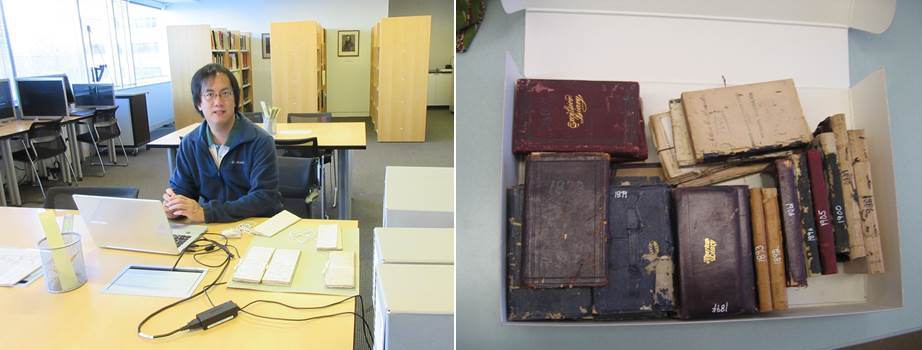
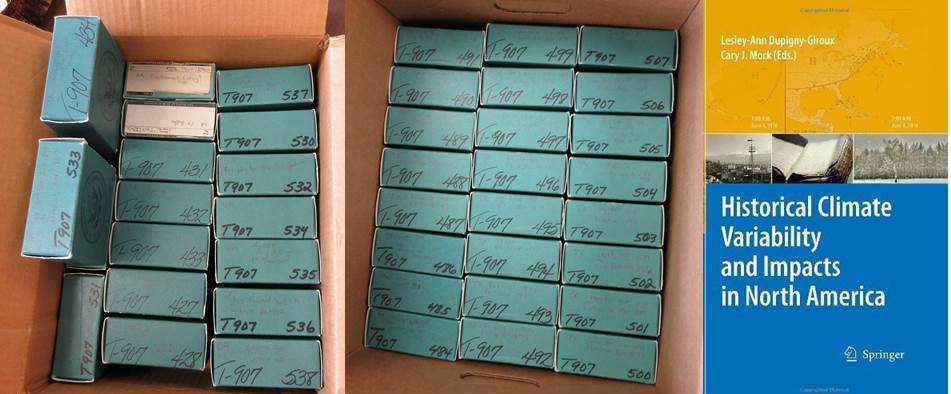
Historical Climatology includes the reconstruction of past weather and climate before the era of modern weather records, as well as the study of past climate impacts on society. Dr. Cary Mock heads most of the activity at the University of South Carolina on historical climatology, a list of his publications is available at Cary Mock, please contact Cary Mock (mockcj@sc.edu) for reprints and more information. Historical climatology is a research area that overlaps historical environmental change, synoptic and applied climatology, paleoclimatology, weather hazards, and history. Excellent and exactly-dated daily weather and climatic observations are available in a wide variety of historical documents and early instrumental records. Documentary historical records include personal diaries, old newspapers, and ship logbooks. A few individuals, such as Thomas Jefferson (the third President of the United States), kept instrumental records.
A combination of these data have great potential to provide a valuable extension of the modern instrumental record back several hundred years. Cary Mock, with Dr. Lesley-Ann Dupigny-Dupigny of the University of Vermont, have published a book on the Historical Climate Variability and Impacts in North America, from Springer that is the primary key book on the topic (picture above). A map shown below reveals in-person archive visits by Mock, some locations such as Washington, DC and London comprise of hundreds of daily visits. Another map shown below illustrates the spatial distribution of just the known early instrumental records from various organizations (ex. the US Army Surgeon General), illustrating the high potential for understanding climate variability over the United States extending back to the early nineteenth century. The historical databases at South Carolina in the Climatology Program at USC, managed by Cary Mock, are extensive, and to date it is the ONLY major academic historical climate research center of its kind in the United States. Daily historical climate records emphasize the Southeast and Atlantic coast, the Great Plains, the far western United States, Alaska, and Hawaii. Support on various projects has been provided through grants from the National Science Foundation and NOAA. More recently, projects have expanded internationally that include databases from Istanbul (Constantinople) Turkey, Belize, Bermuda, Shanghai, Hong Kong, and Japan.

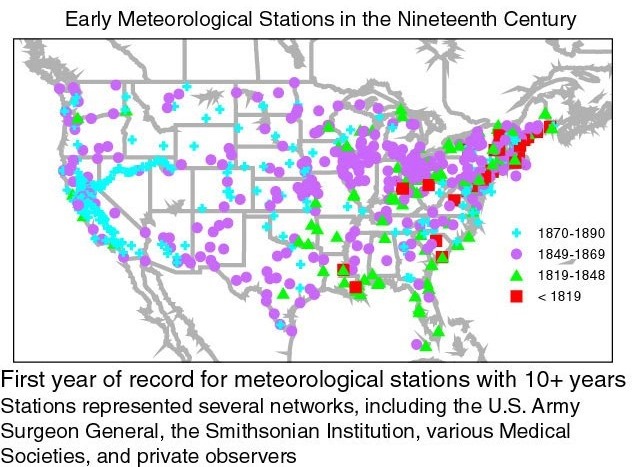
Below is a typical example of a 19th century original instrumental record in manuscript form, this one coming from Copper Island which is located off Siberia in the North Pacific Ocean (Feb. 1883).
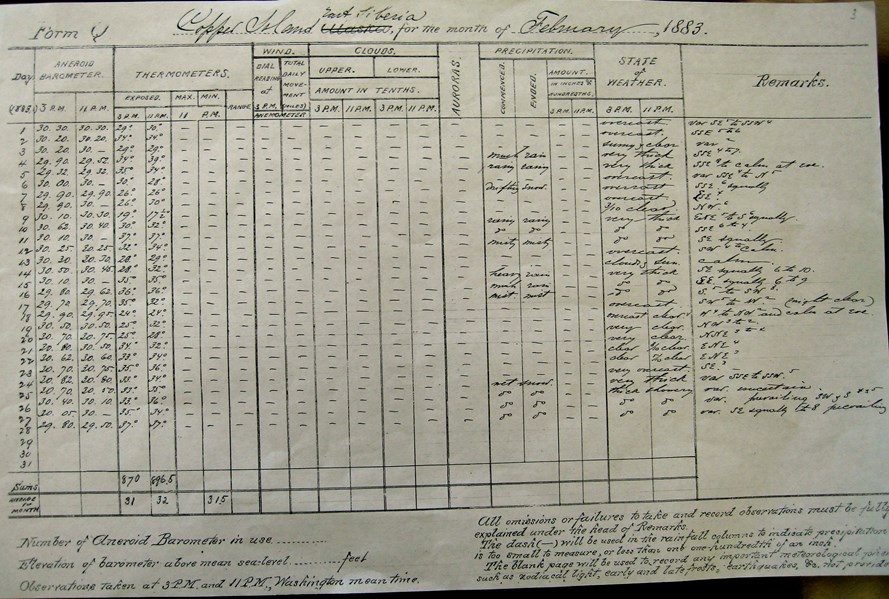
The first ever known systematic meteorological observations in the United States were taken in Charleston, SC by Dr. John Lining in 1738. The instrumental historical climate databases increase dramatically spatially by the early 1800s. For the climatologist, these historical records are important to 1) improve our understanding of interannual and decadal variability of past climate; 2) describing climatic responses as they relate to major synoptic patterns and teleconnections such as ENSO (El Nino/Southern Oscillation), the NAO (North Atlantic Oscillation), and the PNA (Pacific North American) patterns; and 3) assessing decadal climatic variability (ex. drought) that result from forcing factors that occur at hemispheric and global scales.
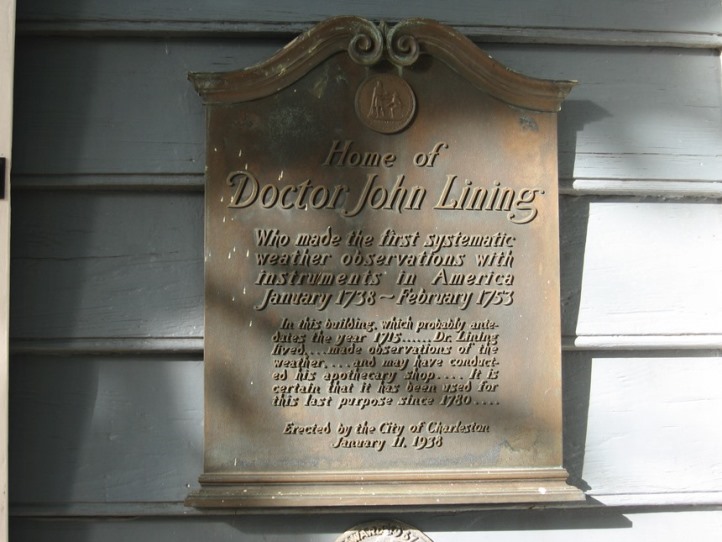
Historical climate data are also invaluable for reconstructing extreme weather hazards, such as hurricanes, snowstorms, snow avalanches, big flooding events, and heat waves. At South Carolina, research has addressed all of these but a big focus has been on tropical cyclones. To date, many new tropical cyclones have been found that were never officially documented in existing hurricane databases. A major theme of research in historical climatology at South Carolina is historical hurricane reanlaysis and reconstruction, which assesses storm candidates from the early 20th century on backwards with time. Research to date focuses mostly on the Atlantic and West Pacific but is expanding globally, and working closely with the National Hurricane Center (NHC) and the HURDAT Project (run by Dr. Chris Landsea of the National Hurricane Center). An example is the Storm of June 22, 1867, one of the few known hurricanes ever to hit South Carolina in the month of June. The track of this storm was reconstructed from a combination of early instrumental, diary, newspaper, and ship log records (see below).
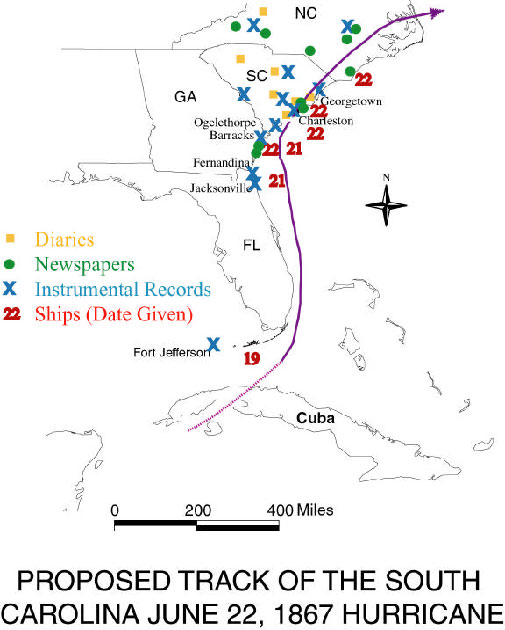
Below are some excerpts of a hurricane in August, 1829 as it impacted South Carolina. This one is another example of storms that is not currently documented in our 'official' list of known Atlantic Basin hurricanes.
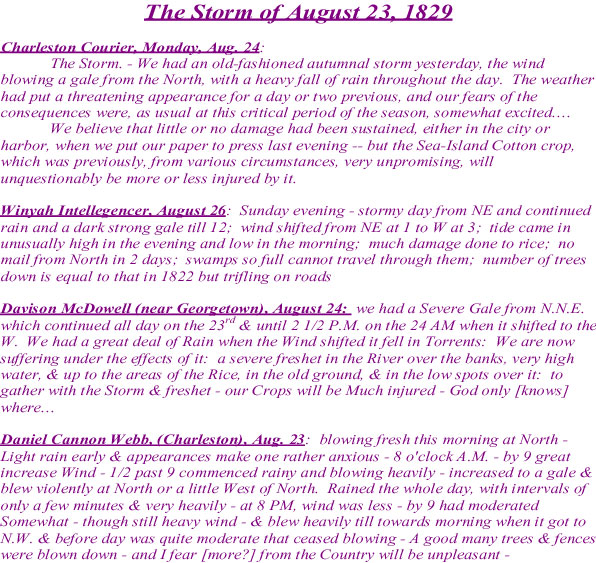
Newspapers and early instrumental data from historical archives for East Asia can also be used to reconstruct and reanalyze past typhoons. Below is an example of a barometric record from Macao, taken from the Hong Kong Daily Press on Sept. 8, 1871:
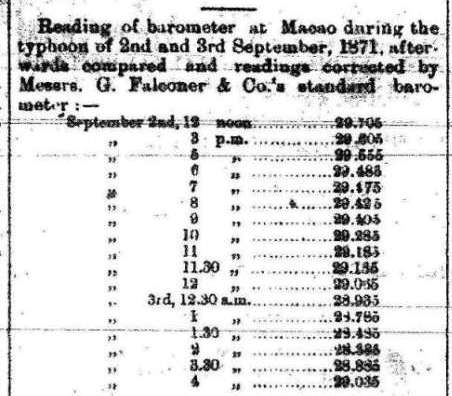
Documentary evidence and early meteorological observations of the American South consist of detailed farmer plantation manuscripts such as those kept by the Black Oak Agricultural Society (the Ravenel Family) near Pinopolis SC, personal papers such as the unique case from the legendary Reverend Alexander Glennie of All Saints Church at Pawley's Island, SC, and from early newspapers such as the Charleston Courier. Most of these manuscripts are kept at historical libraries and societies such as the South Caroliniana Library and the South Carolina Historical Society. Once screened and corrected for data quality issues, these records are excellent sources for reconstruction of long, detailed (daily resolution) climatic time series,identification of weather extremes, and revealing prominent societal impacts.
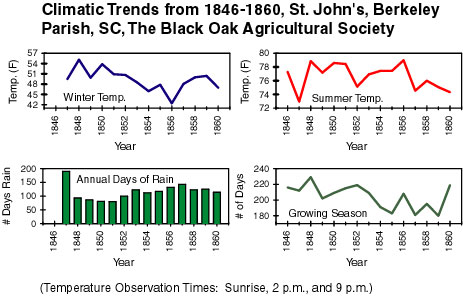
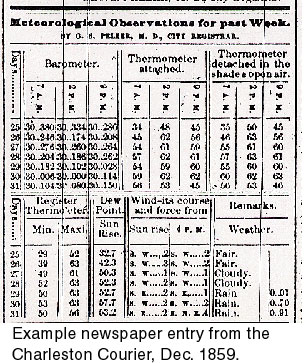
In the past, historical climate work at South Carolina has worked in collaboration with scholars such as Mike Chenoweth (independent scholar) in historical climate reconstruction, Dave Stahle (University of Arkanasas), on integrating the historical climate data with his tree-ring research, Eleonora Rohland (Univeristat Bielefeld) on Louisiana historical hurricanes and related societal impacts, Lesley-Ann Dupigny-Giroux (University of Vermont), and with some Canadian historical climatologists such as Vicky Slonosky's ongoing efforts. Research at South Carolina also assesses U.S. Southeast climate/weather and historical impacts that involve the influence of climatic change as it affected society during the Little Ice Age, the antebellum period, the weather during major Yellow Fever epidemics, as well as during famous historical events such as the sinking of the C.S.S. Hunley during the American Civil War, the first submarine ever to sink a enemy warship. Recently, Silvia Piovan (U of Padova) and Cary Mock are collaborating on a Civil War project involving Sherman's March through South Carolina that includes a weather aspect.
Cary Mock has also done historical climatic research on selected areas of the Western US up to the Alaska and the Western Arctic (Beringia), and for Hawaii. Cary has been particularly interested on issues of climate reality vs. climate perception (ex. Garden and Great American Desert Myths) during the settlement era of the Western United States, including the California Gold Rush year of 1849 which is a major extreme climate year over North American and a big focus on an ongoing book. The importance in understanding climatic reality is vital to fully assess the discrepancy between the real world as compared to the environmental images as viewed by the many westward travelers and early settlers. Recent research with Erika Wise and her CTRES Lab at the University of North Carolina , currently funded by NSF, is ongoing on analyzing major hydroclimatic extremes in the 19th century for the Far West. Below is a compilation of some early meteorological data from San Francisco, CA for the winter of 1861-62 taken from the Daily Alta California, a unique winter characterized by unprecedented record heavy rainfall, which San Francisco got its normal annual total in roughly a 2-week period, and many people traveled around the Central Valley of California in boats.

Below is another example of some early meteorological data, taken at Salt Lake City, Utah and recorded in the Deseret News. October 1856 is a very interesting month, as around Oct. 19, a severe cold and early snow is evident, corresponding to the timing of the Mormon Handcart Company Disasters that caused major hardships and deaths on the trail of emigrants in Wyoming going towards Salt Lake.
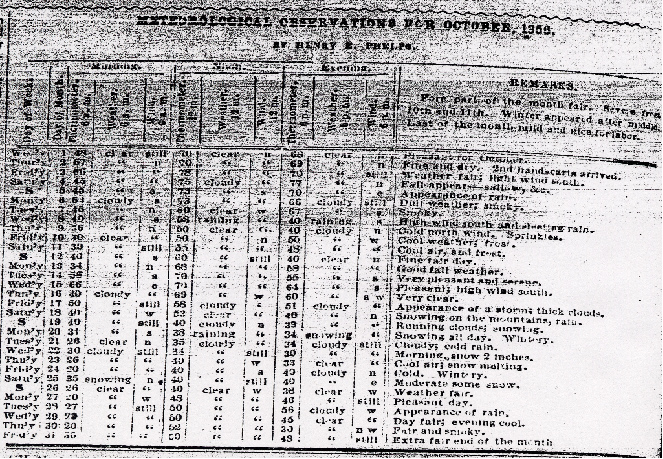
Ship logbooks are very unique data sources of past climate. The quantity of ship logbooks with daily hourly weather observations numbers in many thousands, and are at repositories such as the US National Archives, the UK National Archives, and the New Bedford Whaling Museum. Below is a portion of hourly specifics of a US Navy log, taken from USS Monocacy on 14 September, 1881 at Yokohama, Japan. The Beaufort scale gale-force winds are indicative of a tropical storm or nearby typhoon.
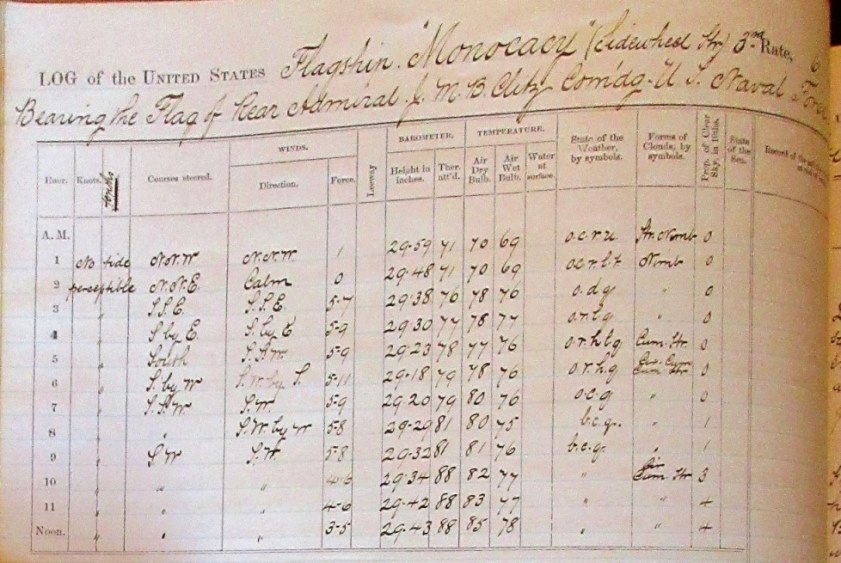
Research at South Carolina has successfully utilized ship logbooks for reconstructing variables such as precipitation frequencies, wind frequencies, synoptic weather patterns, tropical cyclones, and severe winter storms. In the table below, the bark Ohio and the British ship Orozimbo provide excellent examples of demonstrating how logbook data can be used to reconstruct past climate. Both ships remained near 67N, 170W within the Bering Straits between Alaska and Siberia during all of August 1849 which is within a year of extreme weather over much of North America. Logbook data from both ships indicate decreased frequencies of northerly winds; increased westerly and calm winds; increased number of fog days; and decreased number of rain days during August 1849 as compared to climate normals.
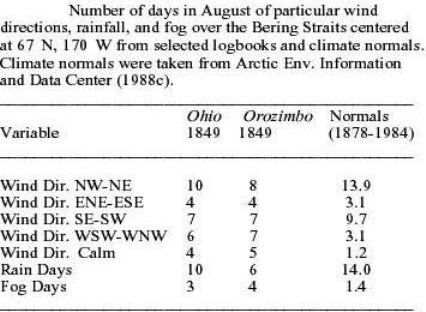
Below is another example, taken from the log of the USS Jamestown in October 1880 at Sitka, Alaska. Hourly trends of the low barometer and high winds, along with a strong push of cold air and snow, depict a very rare storm of "unprecedented" magnitude. This storm has been termed as "The Sitka Hurricane."
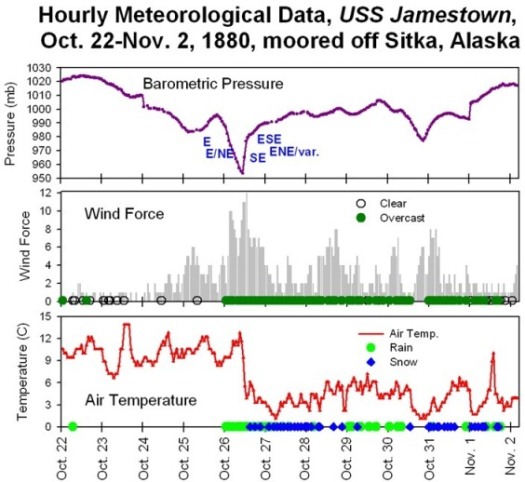
Some historical climate work tries to link weather and climate to ecological, hydrological, and geomorphological impacts. Archives, including newspaper examples in the following for snow avalanches in Juneau AK and Fires in California, document past extremes prior to modern records.
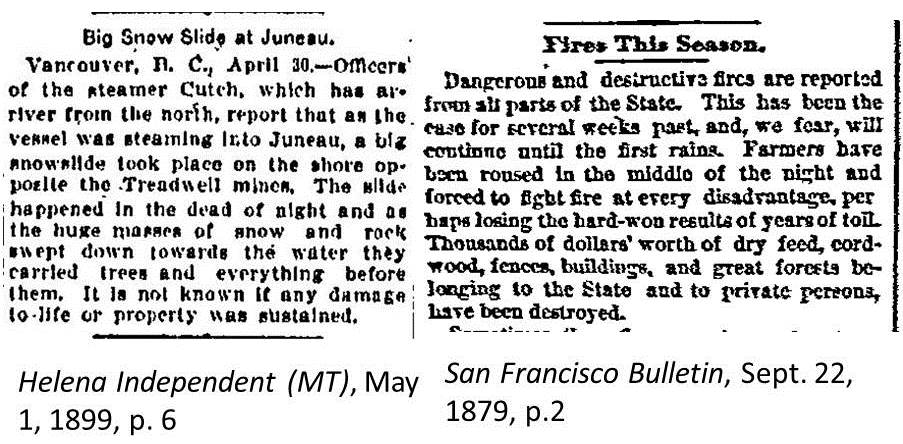
Historical climatology is hard but very rewarding work, as it has the highest temporal resolution of all paleoclimatic proxies and offers a unique perspective on analyzing how society responds to climate and weather extremes. North America currently lacks much work in historical climatology, thus the opportunities for such research is vast and wide open. Much "detective" type work, with good historical skills, is involved in locating and extracting climatic information from historical archives. With Rob Allan (UK Meteorological Office) and Gilbert Compo (NOAA) in the ACRE (Atmospheric Circulation Reconstructions over the Earth) and International Surface Pressure Databank research initiatives respectively, Mock and his colleagues regularly contribute data to these initiatives. The need for close collaborations of climatologists with historical geographers, historians, and archivists is absolutely critical in successful research on historical climate reconstruction and assessment of historical climate impacts.
Please contact Cary J. Mock for additional information.
The views and opinions expressed in this page are strictly those of the page author.
The contents of the page have not been reviewed or approved by the University of South Carolina
Last updated: January 25, 2021 by Cary J. Mock


















